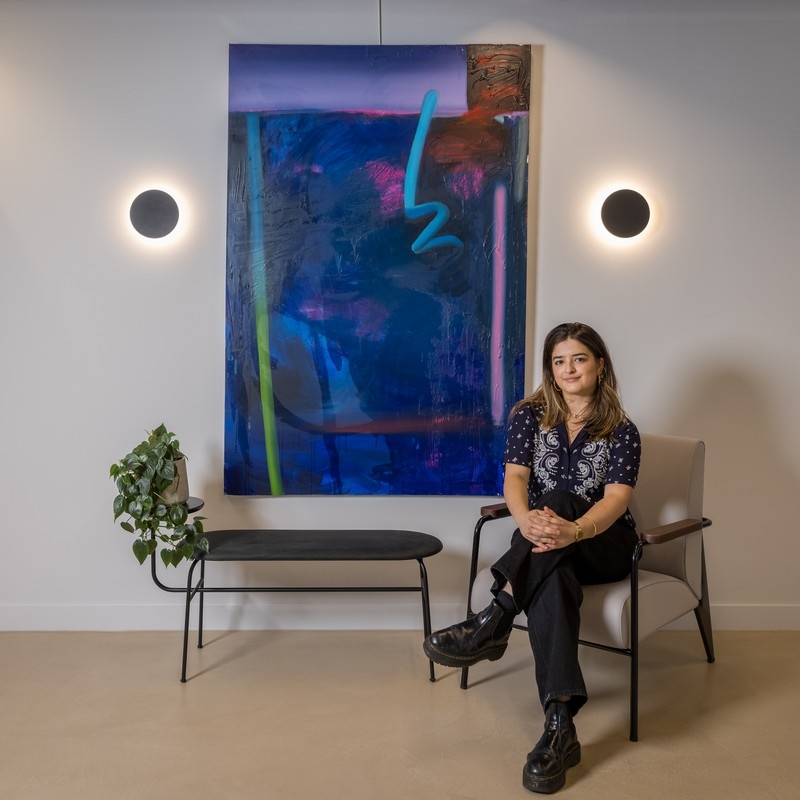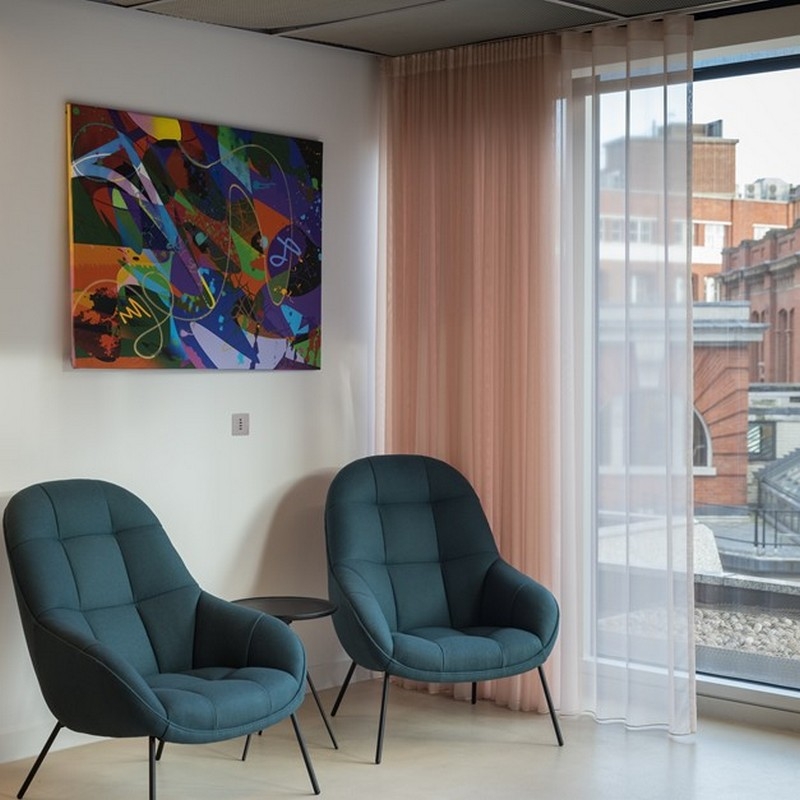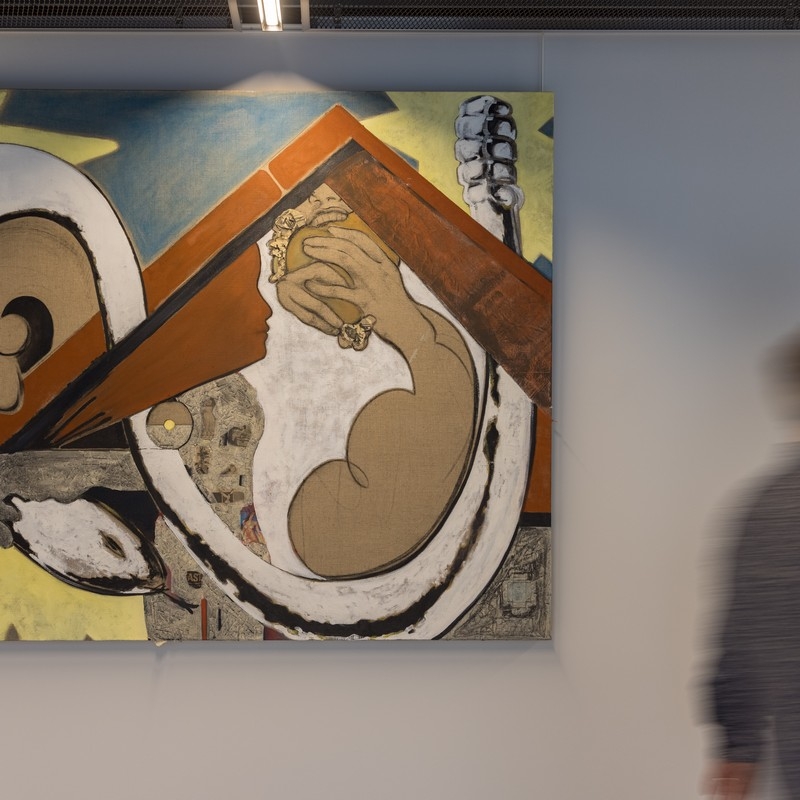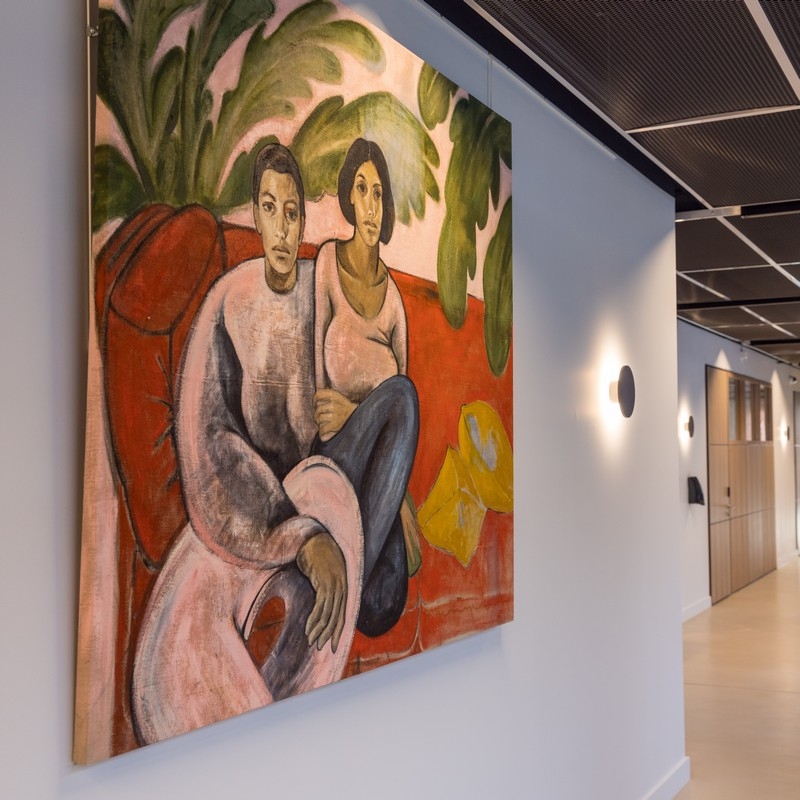When others call art in the workplace a distraction, we say, take a second look. We’re on a mission to change people’s perceptions of art in the office, and not just because they’ve been working from home for so long. At Myo, art is fundamental to our spaces. Why? Because we believe it can do much more than look good on a wall: art can actually help us work better.
When others call art in the workplace a distraction, we say, take a second look. We’re on a mission to change people’s perceptions of art in the office, and not just because they’ve been working from home for so long.
An eye on the future

When we put together our latest collection, we wanted to showcase art from graduates whose degree shows were cancelled this year due to Covid-19. Called 2020 Visionaries, it gives us the opportunity to recognise – and give a platform to – work from some of London’s emerging artistic talents. The BA and MA graduates’ pieces represent a fresh, optimistic outlook of our world, when so much has changed in our own.
And, as we consider life post-crisis, we cannot underestimate the positive impact of using art in the workspace to engage, inspire and reassure now more than ever.
Art as enrichment
Studies by the University of Exeter’s School of Psychology reveal that, “If you enrich a space people feel much happier and work better; a very good way of doing this is by using art.” Dr Craig Knight.
Dr Knight and his team studied the most effective work environments, asking participants to do an hour’s work in four different types of office space:
- Lean: containing only the things necessary to do the tasks.
- Enriched: featuring art and plants which were already arranged.
- Empowered: the same art and plants but participants could choose where to put them.
- Disempowered: participants could arrange the art and plants themselves – but the experimenter then undid these personal touches and reverted to the enriched layout.
The team found that people who worked in the enriched office worked about 15% quicker than those in the lean office and had fewer health complaints – this figure then doubled for people who worked in the empowered space. As for those who’d seen their personal touches undermined; their productivity levels were the same as those in the lean space.
This got us thinking. To explore this concept further, we brought together a panel of experts to discuss the impact of art in the workplace.
Meet the panel
Jo Yarker, specialist work and workplace psychologist, Charlie Smedley, Managing Director at Myo’s art partner A Space for Art, and Jack Kelly, Customer Experience Manager at Myo.
Here’s what we found.
At home with workspace art

We use art to improve productivity and it can actually do this in more ways than you think.
By choosing the right pieces, we can tackle the downsides of our busy work lives, look to blur the boundaries between work and home – and create a setting people feel more at ease in where they can create connections and do great work.
Natural connections
Choosing art with a connection to nature can help create a sense of calm which can also improve productivity.
“There are many studies that show that artificial vistas are almost as good as real life,” explains Jo. “…Art which reflects a natural setting could be helpful for staff. If you can take this further and display a natural setting which moves, even a little bit, that can have even further positive effects.”
This is a concept that Jack knows all too well. As part of an earlier rotation at Myo, the team used a projector to display trees moving in the breeze and waves lapping at the shore. “The impact that piece had was noticeable”, says Jack, “you would walk past it and you might not even register the difference it made to your mood, but there was definitely something relaxing about it.”
Art ‘in the moment’

Serendipitous and social connections make us happy at work, so it goes without saying that a great piece of art (or a terrible one) helps us achieve this.
Art helps encourage social connections. By creating a natural talking point, you’re creating social connections and informal conversations – key in today’s agile environments.
Jo suggests, “We know that having serendipitous conversations at work, particularly when they are informal and not about the task itself, makes a big difference to how happy we are at work. Many businesses are now aware that they need to encourage these regular, small, social connections and art is actually a great way to do that. If it rotates that’s especially good because it not only aesthetically refreshes a workspace, but also because a new interesting piece encourages conversation.
“Getting the balance between a talking point and what is inappropriate is important, but if a piece is different, exciting and interesting or has a story behind it means you are more likely to engage with it.”
Art is your brand
Your wall art is the difference between boring beige walls and a talking point, it’s for staff to engage with – but what it also does is convey a message about your business and brand. Who you are, what you stand for, in a snapshot.
Charlie comments, “Art can be very daunting, especially if it’s not an area you are knowledgeable or interested in personally. Often we find that clients in a corporate setting are naturally inclined to go for something familiar and safe.
“We try to gently encourage clients out of their comfort zone where possible, however the art should reflect the brand and company ethos, shining the best possible light on the way people perceive the company. There is a fine line between too bold or provocative and being aspirational and inspiring. It is important we tread the right side of this line, otherwise art can project the wrong impression on their business.”
Taking pride in the workspace
When it comes to workspace empowerment, as The University of Exeter’s studies show, art plays a key role to how people respond to a space. It can be a natural place to empower staff so they feel involved in workplace decisions and feel pride in their space.
At Myo, we curate each collection with a theme – give our members all the information about it, and help create that sense of pride that adds value to the workspace. Rotating the collections every six months helps keep the space fresh, and forward facing rather than sterile and stagnant.
Art and 2020

Health and productivity aside, there is another important factor never far from Jack’s mind. “Working from home has been given its opportunity to shine, and we would be remiss to think that many people haven’t embraced its benefits. The office space needs to offer something that a home working space can’t.
“Showcasing engaging art that rotates adds to an experience that might not be possible for people at home. We are creating great experiences at work for our customers and their staff.
“I’ve heard customers telling their guests about our recent collection, how we’ve given a platform to students who have missed out due to Covid-19 this year as well as what the pieces are about and what they think of them. It’s great to hear people debating about the art we’re showcasing at Myo.”
If people are talking about the art in your office space, that can only be a good sign. You’re using it not only for the look and feel – but more importantly – bringing an empowered space to your people.
Myo, 123 Victoria Street are displaying the 2020 Visionaries Collection until March 2021, featuring artwork by: Irini Bachlitzanaki, Royal Academy; Liam Bradley, Camberwell College of Art ; Anna Clegg, Chelsea College of Arts; Sam Creasey, Royal College of Art; Olive Curran, Wimbledon College of Art; Gianna Dispenza, Royal College of Art; Jobi Durani, Central Saint Martins; Georgia Fraser, City & Guilds; Jonah Fried, Chelsea College of Art; Diogo Gama, Wimbledon College of Art; Katarina Lalic, Central Saint Matins; George Richardson, Central Saint Martins; Valentin Rilliet, Slade UCL; Andrew Szczech, City & Guilds of London Art School.





